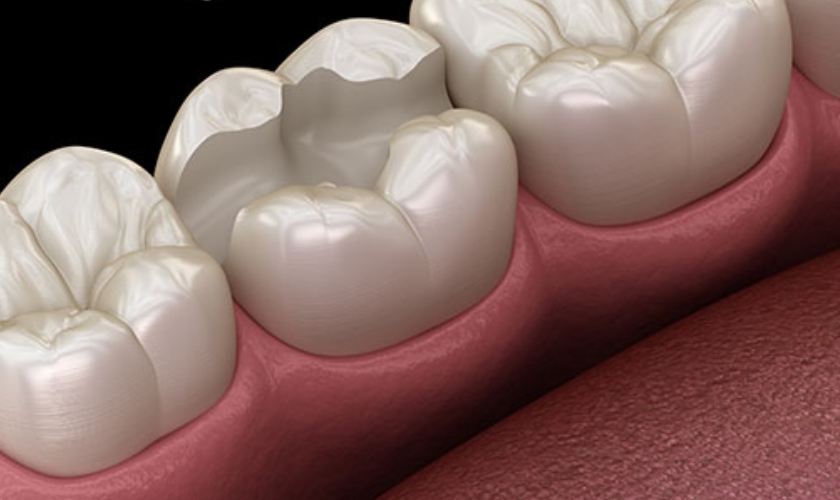332 North York St., Elmhurst, IL 60126

Signs You Might Need an Inlay or Onlay
A healthy smile is vital for overall well-being and confidence. But sometimes, teeth can become damaged due to decay, cracks, or fractures. While traditional fillings can address minor issues, more extensive damage might necessitate a stronger and more durable solution: inlays and onlays.
Inlays and onlays are custom-made dental restorations that offer a superior alternative to traditional fillings when a significant portion of the tooth structure is compromised. They are crafted from strong, tooth-colored materials like porcelain or gold, ensuring both functionality and aesthetics.
But how do you know if you might be a candidate for an inlay or onlay? This blog explores the telltale signs that indicate your teeth might need this type of restoration.
Signs You Need an Inlay or Onlay
Traditional fillings are fantastic for addressing minor cavities and tooth decay. However, inlays and onlays come into play when the damage is more substantial. Here’s when you might need to consider them:
Extensive Tooth Decay
If a cavity is large and compromises a significant portion of the tooth’s surface, a traditional filling might not offer sufficient support and structure. Inlays and onlays provide a more substantial restoration that can withstand greater biting forces.
Cracked or Fractured Teeth
Minor cracks in teeth can often be repaired with fillings. However, if the crack is deep or extends onto the chewing surface (cusp) of the tooth, an inlay or onlay might be necessary to restore strength and prevent further breakage.
Large, Worn-Down Teeth
Over time, teeth can become worn down due to grinding, acidic foods, or other factors. When a significant portion of the tooth structure is lost, an inlay or onlay can restore its shape, function, and biting surface.
Replacing Old or Faulty Fillings
Large or old fillings can become loose or ineffective over time. If a large filling needs to be replaced, an inlay or onlay might be a more durable and long-term solution.
Symptoms That Can’t Be Ignored
Beyond the type of damage, specific symptoms can indicate the need for an inlay or onlay:
- Pain or Sensitivity: Pain, especially when biting down on hard foods, can be a sign of underlying damage that might necessitate an inlay or onlay to address the issue and restore functionality.
- Chipped Teeth: Chipped teeth, especially those involving the biting surface, can compromise the strength and integrity of the tooth. Inlays and onlays can effectively restore chipped teeth and prevent further damage.
- Difficulty Chewing: Difficulty chewing due to pain or discomfort can be a sign of a damaged tooth structure. Inlays and onlays can restore the tooth’s chewing surface, allowing you to enjoy a variety of foods comfortably.
- Cosmetic Concerns: Large fillings or damaged teeth can affect your smile’s aesthetics. Inlays and onlays are typically made from tooth-colored materials, restoring the natural appearance of your teeth.
Benefits of Inlays and Onlays
Inlays and onlays offer several advantages that make them a valuable option for tooth restoration. They are remarkably strong and built to endure the pressure of chewing, lasting considerably longer than traditional fillings. Additionally, inlays and onlays prioritize the preservation of your natural tooth structure. Unlike crowns, which require more extensive removal of healthy tooth material, inlays and onlays only target the damaged area. Lastly, these restorations are crafted from tooth-colored materials, such as porcelain, to seamlessly blend in with your natural smile, enhancing its overall appearance.
Early Diagnosis is Key
If you experience any of the signs mentioned above, scheduling an appointment with your dentist is crucial. Early diagnosis and intervention can prevent further damage and ensure a successful outcome with inlays or onlays. During your appointment, your dentist will:
- Perform a thorough oral examination. This will involve a visual inspection of your teeth, X-rays to assess the extent of the damage, and possibly other diagnostic tests to evaluate your overall oral health.
- Discuss your symptoms and concerns. Sharing any pain, sensitivity, or difficulty chewing you might be experiencing will help your dentist determine the best course of treatment.
- Recommend the most suitable restoration. Based on the type and severity of the damage, your dentist will recommend the most appropriate restoration, whether an inlay, an onlay, a crown, or another option.
Inlays and onlays represent a significant investment in your oral health. By practicing good oral hygiene, maintaining a balanced diet, and avoiding detrimental habits such as smoking, you can ensure the longevity and success of your restorations.
Recognizing signs that indicate the need for an inlay or onlay can empower you to take proactive steps to preserve your oral health and prevent further damage. If you observe any of these signs or have concerns about your teeth’s condition, schedule a consultation with your dentist for personalized care and treatment options.
If you suspect you may require an inlay or onlay dental restoration, contact our dental office today to arrange an appointment. Our professional dentist is dedicated to delivering comprehensive care and assisting you in achieving a healthy, confident smile.


